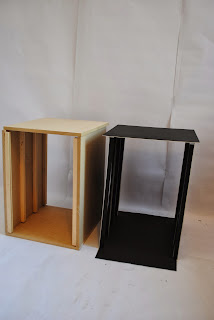For the initial construction of my second attempt at model making, I went about gluing the ridged staggered along the height of the box. I wanted slots for four layers. This meant 16 of these 1.5cmx42cm length of wood. Two for each ridge. Aware of my lack of technical skills when it came to model making, I was vigilant with measuring up and ensuring the ridges matched up to avoid any mistakes. I also sought out the assistance of my housemate to hold the pieces of wood as I drilled and screwed the pieces of wood together. Despite, not drilling my fingers off and successfully constructing the box, I would much rather make any future 3D structures in the workshop, where I have access to an appropriate environment for drilling.
I did have some trouble with splitting in the MDF whether the nails were too big for the 12mm width. This is a important issue I need to consider in the future experiments.

There is an obvious comparison between my two model boxes. I am very glad that I pursued the construction of a wooden box. Even though, it is still unfinished, i.e. I need to spray paint it black. It looks much sturdier. I do however have the fact it was suggested to create a landscape box as an issue. After putting the box together, it became apparent that the scenes I had previously cut by hand were too big for the slots, even with some of the scenes having space to be cropped, other layers such as the ornate seaweed border, were too delicate to be cropped any more. Therefore they had to scrapped form the final images. This is very annoying as the main reason that I decided to keep the set box portrait was so that i didn't need to re cut already made image. Anyhow, I can only take this as a lesson to be more considerate of measurements.
On a separate note, I am unhappy with the box being on the floor, it limits the viewing experience for the audience/viewer as well as limiting angles in which light can be shone onto the model and scenery. I have though up a solution to use a coffee table as a plinth to raise the model of the floor. I had also bought a king size white sheet as a solution to my issues with dodgy studio backgrounds. Instead, i am going to use it to cover the coffee table.
For the initial photo shoot, i secured the lights to the lid of the model box in a looped shape. This essentially allowed me to control the lighting. It also worked as if the model box was a room, being lit form lighting from the ceiling. It was also neat and wasn't too obvious to the viewer how it was being lit. The rest of the lights, wrapped around the table to create a barrel like image in the composition.
On the other hand, the lighting positioning seemed to work better with some scenes and not so much on others. I think perhaps the fact the model box is still unpainted is an added issue to photographing the scenes. Similarly to the first model box, the light colour of the wood means differing coloured shadows are projected onto the surrounding walls. This is increasingly become a distraction from the paper cuts. Also I don't like that the audience are able to see what the box is made from. In a theatrical environment, an audience will not be able to see the structure of the theatre (unless it is intentional). This supports the theory that traditional theatre creates an illusion of reality. My approach to this text is not dadaist. I am complacent to make my audience concentrate on the imagery i have made rather than ponder on why I've created it.
Unfortunately, my initial plans to create shadows through negative space images did not work as planned. Although, the delicate design of the bottles worked quite well by themselves ( see last three images). Similar to my experimentation with shadow making on my A1 3D anchor/chandelier, I was able to create a double shadow behind the model box. I find that the shadows created behind when shooting the image can be just as effective as the layered images themselves. I intend on exploring more how I can manipulate the shadows to create separate images. Perhaps if I hand cut stencils and shone a light through them as i did with the window I may be able to create more of an installation experience for the viewer.




























































